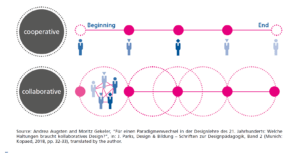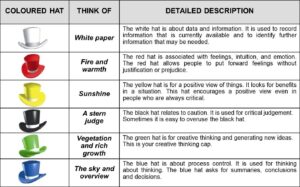Parallel Thinking
Intro to Parallel Thinking- The Rationale Behind Group Problem-Solving
The essence and importance of group problem-solving and decision-making are frequently emphasized in academia and the business world. Because the majority of decisions today are made by groups of people, the subject of group problem-solving becomes an important one.
Although individuals can learn and demonstrate knowledge about group size, cohesion, conflict, and participation in problem-solving and decision-making, being placed in a group facing a specific problem and having to think and interact in a way that assists the group in solving the problem is quite another story.
Edward de Bono (the main proponent of Parallel Thinking) posits that the main obstacle to thinking is confusion. We frequently attempt to think about too much at once. When we encounter a problem; facts, feelings, and fresh ideas all arrive at once, confusing us. When a group is working on the issue, this confusion is only made worse. The group generally thinks at odds with one another (perpendicular) rather than in unison (parallel).
Along with the confusion, de Bono talks about thinking as challenging due to its nebulous nature and intangibility This makes it challenging to be conscious of your own thinking and even more challenging to communicate it to others. By identifying and naming particular thought patterns, we can start to recognize them and give them a physical form. By giving the thought process a more concrete form, we can start to consider our own thinking as well as that of others. In doing so, we begin to equate thinking with solving a capital budgeting problem.
Group Parallel Thinking vs. Conventional Thinking for Problem-Solving
The best way to understand parallel thinking is to compare it to conventional argumentative or adversarial thinking. In a traditional argument or adversarial thinking, each side adopts a different stance before attempting to attack the opposing viewpoint. Each side tries to disprove the other side’s claims. The Greek Gang of Three (Socrates, Plato, and Aristotle) established this school of thought over 2,400 years ago. There is not a single element of constructive, creative, or design in adversarial thinking. It was never meant to be used to construct anything; only to learn the “truth.”
On the other hand, parallel thinking is presented when all parties think simultaneously in the same direction. To get a complete picture of the situation, the direction of thinking can be changed. Each thinker, however, is constantly thinking simultaneously with every other thinker. There is no requirement for agreement. Contradictory claims or ideas are not refuted, but rather laid out side by side. De Bono encourages problem-solving teams to mentally put on a hat of a certain colour and switch them when necessary.
Parallel Thinking is a Collaborative Process
At its core, parallel thinking is a collaborative and ideally multidisciplinary approach. That is the biggest difference from classical design as well as from other disciplines. While traditional projects in the corporate world, the classical design world, and also in the social sector are usually based on cooperation, parallel thinking is based on collaboration. Cooperation in this sense means that people work together as a team but are not necessarily all involved in all steps of the process.
A parallel-thinking team on the other hand ideally works together and decides together, therefore each team member is involved in all steps of the process. In order to ensure that this collaboration works well for the team members and also that it produces results within an acceptable time frame, design thinkers make use of three core elements: people, place, and process.

In his 1985 book Six Thinking Hats, de Bono describes how the method is used by deliberately donning and removing each of the six thinking hats. The different colors of the hats enable the thinker to picture or imagine donning or removing a particular hat. The right moment arises to invoke each way of thinking. The various forms of thought become more concrete and, consequently, more approachable when they are given names. We develop a map of the problem space by looking into a subject in this way. The point of the six thinking hats method is to have the mind focus on mapping entire possibilities for solutions before choosing the best course of action.
Here, an individual’s imagination is engaged. By purposefully donning various hats using imagination, we are able to get around ego defense, which is the primary obstacle to creative thinking. It is possible to temporarily put one’s ego aside because donning one of the thinking hats is similar to playing a part. The method also narrows our focus to one aspect of our thinking, such as the knowledge we have of certain facts or information or the fresh approaches we can come up with to a problem.

Figure 2 The Six Thinking Hats
The method also concentrates our thoughts on a particular aspect of our thinking, such as what data or information we are aware of or what fresh concepts we can come up with to address the issue. Additionally, it creates a set of guidelines for thinking. Having a clear paradigm makes thinking fun. Now we have the ability to ask people to don a certain thinking hat or take it off. We can also put on or remove the hat we’ve chosen. It gives us a technique for making thinking concrete so that we can discuss and act on the thinking process. de Bono notes that naming various thinking techniques helps us to understand a foreign process.
Six Hats Technique: Integrating Multiple Thinking Styles, Personas and Perspectives
An online article (https://bit.ly/3cSnBlp) explains this simply.
Green Hat
- Thinking Style: Green-hat thinkers tend to be creative, imaginative and look for alternatives, but may not think through the consequences.
- Typical response: “Of course, we could always buy a new system.”
Blue Hat
- Thinking Style: Blue-hat thinkers tend to see things from a broader perspective. They have the ability to stand back and look at the bigger picture.
- Typical response: “When the new system is in place it will speed up the process throughout the whole business.”
Yellow Hat
- Thinking Style: Yellow hat thinkers tend to be positive, constructive and look for ways of making something work.
- Typical response: “I’m sure we can make the old system work if we all put our minds to it.”
Black Hat
- Thinking Style: Black hat thinkers tend to play ‘devil’s advocate’ and point out what might go wrong.
- Typical response: “The new system is only half the solution, what about late deliveries from our supplier, it won’t resolve that problem?”
White Hat
- Thinking Styles: White hat thinkers tend to focus on facts, figures and logic.
- Typical response: “How much is the new system going to cost and how many customers can it cope with?”
Red Hat
- Thinking Style: Red hat thinkers tend to use hunches, ‘gut feel’, intuition and previous experience.
- Typical response: “I have a good feeling about it, I’m sure it will work because I’ve seen it work for other businesses.”
Making a Strong Case for Parallel Thinking
Most of the major problems in the world today persist precisely because we have such an excellent method of problem-solving. This statement is not intended to be sarcastic. We do have an excellent method of problem-solving. It is so good, however, that we have come to believe that it will solve all problems. So, we have not bothered to develop any other method. The good is often the enemy of the best. If something is very good then we stop there and cloak ourselves in complacency.
What is this excellent, traditional, method of problem-solving? It is yet another example of the basic belief that if you `remove the bad things’ you will be left with the good things. So, the general method is that you analyse the problem, identify the cause and then proceed to remove the cause. The cause of the problem is removed so the problem is solved. It works! Well, de Bono argues that this general method is simple and it works well, when it works. But there are some problems where you cannot find the cause. There are other problems where there are so many causes that you cannot remove all of them. Then there are problems where you can find the cause, but you cannot remove it. What do we do in such cases?
By adopting a parallel thinking stance, while acknowledging the excellence of the general method of solving a problem by identifying and removing the cause, we also need to do something about those instances where the method simply does not work. Are these insoluble problems? Possibly, but we ought at least to try some other methods.
Conclusion: Practising Parallel Thinking
Now, why don’t you give this wonderful methodology a try within your teams
- Select a topic for discussion (e.g. an idea a team came up with).
- Have someone lead the meeting (blue hat).
- Explain each hat in turn and give the group some time to discuss the subject from that particular hat’s point of view.
- Encourage them to record the conversation on a board so that you can expand on it later.










